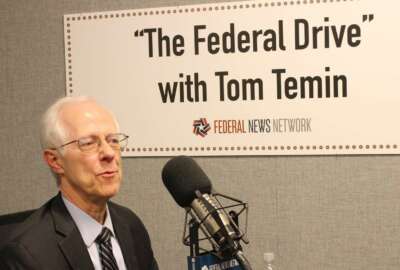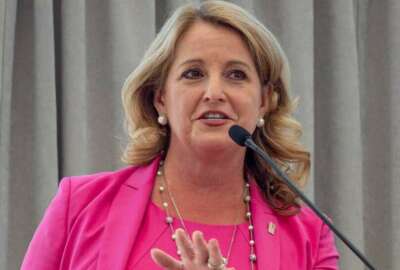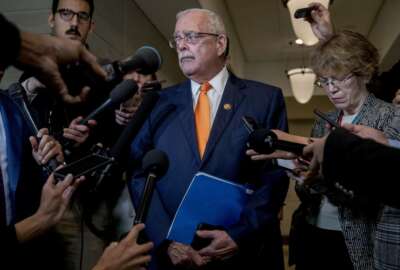
Congressman argues for boosting Technology Modernization Fund by 40x
House Democrats in their latest stimulus bill included a billion dollars for federal IT modernization after a $3 billion proposal was left out of the CARES Act.
Best listening experience is on Chrome, Firefox or Safari. Subscribe to Federal Drive’s daily audio interviews on Apple Podcasts or PodcastOne.
House Democrats in their latest stimulus bill included a billion dollars for federal IT modernization. That’s after a $3 billion proposal was left out of the Coronavirus Aid, Relief, and Economic Security (CARES) Act. Current funding for the Technology Modernization Fund is only $25 million. So why the need for so much more? This week Virginia Rep. Gerry Connolly (D), in an online discussion hosted by CompTIA and several other associations, explained why.
Interview transcript:
Gerry Connolly: There’s a recognition that it’s got to be significant enough to catalyze agencies financially to retire these legacy systems they’re maintaining and invest in their replacements. And frankly, the amounts appropriated in recent years just don’t do that. They don’t even begin to do that. And if you’re a manager of a federal agency, and even if you are inclined to accept the recommendation of your CIO, to retire a legacy system, that’s a multi-billion dollar, multi-year effort, and it’s going to be phased in. And you got to figure out the right technology to replace it. And when you experience a big budget cut, all of a sudden that as a top priority starts to fade. And now you’re worried about maintaining the mission of the agency you had, trying to keep people working not, you know, avoid [reductions in force], and so forth. And all of a sudden that the big dollar package to replace your technology system falls in the list of priorities. And that happens routinely in this administration, because so many agencies find at budget time that they’ve had, you know, big, big cuts, [USAID], EPA, you know, lots of agencies – State Department – that have experienced real big, 30%-plus budget cuts, and all of a sudden this falls in the priority prioritization. So we’re trying to counter that by providing a critical mass that will have support in Congress.
Tom Temin: I asked Connolly why the TMF is always such an uphill push in Congress?
Gerry Connolly: Why doesn’t it have support in the Congress? Well, for a lot of members of Congress who are not particularly familiar with the subject, and that’s most of my colleagues, we already spend $96 billion a year in IT. So why do you need more? And so it’s counterintuitive that well, we have to explain “Well, yeah, but $96 billion is mostly spoken for.” Eighty percent of it goes to maintain these systems. And so we don’t have a lot of leftover capital to invest in brand new systems that are very expensive. They’re going to take time to train people, equip people, and implement those new systems – install and implement. So it’s an uphill struggle to try to educate our colleagues. And I wish the $3 billion had survived the Republican Senate but it didn’t. And maybe the $1 billion is a manageable enough number for my colleagues that it might survive. My hope is it will, we’ll see.
Tom Temin: Given the low interest in the TMF agencies have shown, I asked Connolly whether they need a push on the management side to want modernization?
Gerry Connolly: There I think we fall back on the framework, the legal framework we created in the FITARA bill, the Federal Information Technology Acquisition Reform Act, right? So we’re about – we’re coming up on the, I think the fifth or sixth anniversary of FITARA, having our 10th oversight hearing on the scorecard. There are seven areas we score agencies on, you know, data center consolidation, moving to the cloud, intellectual property management, and the relationship of the CIO to the head of the agency. Some of this is about management. It’s as simple as that, right? So if the CIO has the ear of the boss, and everybody knows that, it’s automatically a priority when I got a call from a CIO. If the CIO is still reporting to the deputy assistant undersecretary for widgets in the basement, you know, employees understand that’s not a top priority, obviously, for the boss. And so we continue to make progress. But it’s, you know, it’s a slow evolutionary kind of progress, not a revolutionary kind of progress. Now, will the pandemic aftermath change that? I’m hopeful it will, because I think we’ll talk about it, but, I think the pandemic has really exposed the weaknesses in our IT system at every level – federal, state, local.
Tom Temin: You’re listening to my recent online interview with Virginia Congressman Gerry Connolly. We also discussed how the pandemic has been a pressure test for federal IT systems, at least for some agencies like the IRS.
Gerry Connolly: I’ll highlight three failures at the federal level, or at least challenges, right? You mentioned the IRS, Tom. IRS was deliberately starved by Republican Congresses for eight years, in technology investments. And that only got turned around when the Republicans passed their tax scam bill, and that put more burden on IRS to implement. But prior to that for eight long years, they cut over a billion dollars in the IRS’ budget. It affected every facet of IRS operations. And they did it for ideological reasons. Because from their point of view, IRS is the source of revenue that feeds the beast, the beast being the federal government. And so out of ideological aversion to the IRS, as this big intrusive federal entity that finances the whole enterprise, they were more than willing to starve it. And so IRS has some of the oldest IT systems in the federal family. And what can go wrong with that? Well, when we put a burden on IRS to get checks out to every American, if you had automatic deposit – about 70 million Americans did – that worked fairly well. But once we got to paper checks, the IT systems just weren’t up to the job. They couldn’t handle the volume. And so we’re doing now 5 million checks a week. And and that means that probably we’re going to – we’re not going to reach every American as was intended until September. That’s a monumental failure and problem. And it’s, frankly, a deliberate strategy. It’s not because of IRS’ inherent, you know, failures. It was a deliberate strategy for Congress.
Tom Temin: Problem agency number two: the Small Business Administration.
Gerry Connolly: At SBA, we’ve got a small agency of the federal government that suddenly has this explosive new mission, that exponentially expanded the dollars it was expected to manage and do it quickly. And so what happened was we changed the criteria for eligibility. We expanded broadly the eligibility, we insisted on a fast timeline. The demand was even greater than anybody anticipated, which is why we had to do a second tranche of the PPP money. And we wanted them to expand the financial institutions they normally do business. So if we’re going to get to Main Street small businesses, you got to be dealing with local banks and local credit unions and, you know, CDFIs and like. You can’t just rely on the regular banks who are normally in your portfolio. And remember that the volume that we expected SBA to deal with was at least 10 times the volume they would normally handle over a decade. We expected them to do all of this in the month. Um, their main IT system is E-Tran. And E-Tran has routinely crashed because of the volume. Though that I think makes sense given the scope of the economic collapse we’re talking about. And so several million small businesses finally did apply and get PPP loans that many of which are forgivable, but there are 40 million small businesses in America. And so that means a huge swath of businesses still have not been touched, which I think argudes for the fact that we’re going to need more money but the IT system at SBA was part of the reason a lot of people didn’t get their loans.
Tom Temin: Connolly’s issue number three is governmentwide.
Gerry Connolly: Telework: So, for years, there have been a number of us saying, push up the telework eligibility the federal government. We find reached about 20% of the federal workforce that was eligible to telework. And the – this administration two years ago, consciously decided to roll that back. And it started with Secretary Perdue at USDA, at the Agriculture Department, walking around one day and he tried to get somebody. And he was told that somebody was teleworking and he said, that’s it. Nobody can telework more than once a week, and which, by the way, really defeats the whole point of teleworking, and we need stricter criteria for who is eligible. Then the administration systematically dismantled a big pilot program of telework at Social Security and other agencies as well. And so when the pandemic hit, of course, we needed people working remotely. Remember the federal workforce is 2.1 million people but you have easily that many, maybe more, who are federal contract employees who serve the federal government under contract and they’re expected to show up to work if the federal government is not shut down. And so there was enormous chaos. OPM had no clear guidance. It took them five memos to actually provide guidance of whether you could, and how could you, and who made the decision. And then they issued a statement about reopening the federal government and that was equally confusing. But the technology infrastructure was not there to have a robust continuity of operations plan.
Tom Temin: Virginia Congressman Gerry Connolly from my online interview, hosted by CompTIA. We’ll post the segment at www.FederalNewsNetwork.com/FederalDrive. Hear the Federal Drive on your schedule. Subscribe at Apple Podcasts or Podcastone.
Copyright © 2025 Federal News Network. All rights reserved. This website is not intended for users located within the European Economic Area.
Tom Temin is host of the Federal Drive and has been providing insight on federal technology and management issues for more than 30 years.
Follow @tteminWFED





